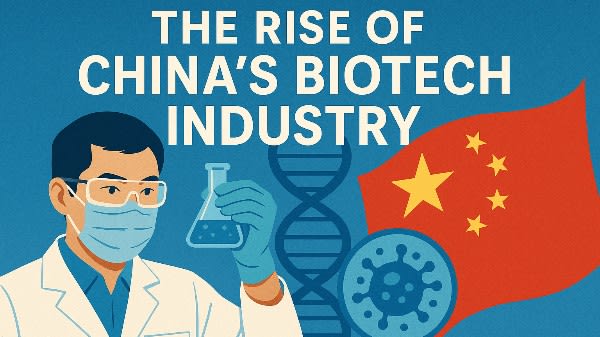Introduction
For decades, the United States has dominated the global biotech landscape, accounting for nearly half of worldwide pharmaceutical revenue. China, meanwhile, was primarily known as a producer of low-cost generic drugs. Now, this dynamic is rapidly changing.
Over the last 5 years, China has emerged as the world’s second-largest developer of new medicines. Morgan Stanley projects annual revenue from drugs originating in China could reach $34 billion by 2030 and $220 billion by 2040.
Recent Developments in China’s Biotech Scene
In 2022, Chinese biotech firm Akeso licensed its newest cancer drug Ivonescimab to American company Summit Therapeutics for $500 million upfront and up to $5 billion in royalties. The experimental drug had astonishingly outperformed the best-selling medicine in the world, Merck’s Keytruda, by nearly doubling patient survival times in trials.
Since then, cross-border out-licensing deals have surged. In 2025, Jiangsu Hengrui Pharmaceuticals signed a record-breaking US$12 billion contract with GSK, while 3SBio reached a US$1.25 billion agreement with Pfizer, the highest upfront payment ever for a Chinese biotech asset. According to NextPharma, China’s total out-licensing value reached $46 billion in 2024, and by mid-2025, one-third of all global licensing deals involved China-made drugs.
Licensing as China’s Competitive Edge
Western pharmaceutical giants are facing a “patent cliff,” the expiration of exclusivity rights on blockbuster drugs worth more than $115 billion annually. To replace those revenues, many are partnering with Chinese firms whose research and development costs are dramatically lower.
Drug development in China is cheaper and faster, supported by lower labour costs, streamlined clinical trials, and a vast pool of research talent. The country produces over 5 million STEM graduates a year, and nearly half of its PhDs come from elite “Double First Class” universities.
China’s real advantage lies not only in cost but also in how it structures its deals. Unlike the large-scale mergers that define Western pharma (Pfizer’s recent acquisition of Matsera), China’s expansion relies on licensing, not acquisition. Licensing enables domestic innovators to retain control and revenue rights domestically while leveraging global partners for distribution abroad. For Western companies, it offers access to cutting-edge technology without triggering political or national-security scrutiny that full takeovers often face.
According to Morgan Stanley, licensing provides a 76 per cent discount in net value compared with traditional M&A. Acquisitions are expensive, politically sensitive, and frequently delayed by investment-review processes, particularly when health or genetic data are involved. Licensing deals, by contrast, are legally cleaner, share risk more evenly, and can be completed in months rather than years.
This structure provides Chinese firms with a dual advantage: global exposure without sacrificing ownership. It’s a strategy that blends commercial pragmatism with policy ambition, and it’s attracting billions in foreign investment.
Regulation, Capital, and Confidence
China’s regulatory landscape has evolved to match international standards. The average approval time for clinical trials has decreased from 501 days to 87, and its drug-approval system now aligns with that of the FDA and European Medicines Agency, making it easier for Chinese drugs to reach foreign markets.
Capital-market reform has further accelerated growth. In 2018, the China Securities Regulatory Commission introduced fast-track IPO routes for high-tech “unicorns,” while Hong Kong’s Chapter 18A allowed pre-revenue biotech firms to list for the first time. The launch of the Shanghai STAR Market in 2019 added liquidity and investor confidence.
The impact is visible on trading floors: the Hang Seng Biotech Index rose 61.8 per cent in the first half of 2025, while the US S&P Biotech ETF fell 6 per cent. More than 400 Chinese biotech companies are now publicly listed across mainland China, Hong Kong, and the US, together worth US$1.5 trillion.
How Legal Teams Get Involved
Intellectual Property (IP) Lawyers
- Draft and register complex multi-jurisdictional patent licences
- Define exactly which rights, from usage and sub-licensing to royalties, are being transferred
Data and Regulatory Counsel
- Navigate China’s Data Security Law and Biosecurity Law, which classify genetic data as sensitive
- Ensure that cross-border sharing for clinical trials complies with export control rules
Antitrust and Competition Lawyers
- Assess whether large licensing deals could distort competition in specific therapeutic markets.
- Manage filings with regulators in China, the EU, and the US
Together, these departments bridge science, law, and commerce, translating breakthrough research into legally sound and globally impactful partnerships.
Future Outlook
This evolving environment will be defined by both regulatory friction and commercial opportunity, with geopolitics remaining a key variable. US tariffs, export controls, and the BioSecure Act could slow collaboration, but the economic incentives on both sides are too strong to halt it completely. As Western firms confront shrinking patent portfolios, China’s role as a source of affordable innovation will only deepen.
